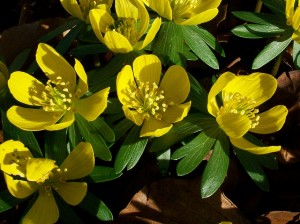Eranthis
This group consists of seven low-growing (3 to 6 inches), hardy, deciduous plants, which grow from tubers. Commonly known as Winter Aconite, these plants bloom in the winter or early spring; they even bloom before Crocuses emerge. Winter Aconites grow wild in the woodlands of Europe and Asia and belong to the Buttercup family, Ranunculceae. The flowers emerge before the foliage and brighten winter's gloomy days. Each stem is crowned with a bright yellow or white, cup-shaped flower, which is surrounded directly underneath by a ruffle of contrasting bright green foliage. The basal leaves appear after the flowers. The flowers openly widely on sunny days and close into small balls on cloudy days. They are perfect for growing under deciduous shrubs or among Snowdrops and Crocuses. In suitable conditions, Winter Aconites will naturalize by reseeding themselves. E. cilicica and E. hyemalis are the most commonly sold species. They both have yellow flowers and the foliage of E. cilicica is bronze at first, turning green with age.
Pot Cultivation
Winter Aconites can be grown from zones 3 to 7. They need a winter temperature at least as low as 20� F; they are hardy down to minus 30� F. In late summer or early fall, as soon as you obtain the tubers, plant them 5 inches deep and 1 or 2 inches apart in well-drained (but moist), organic, neutral to alkaline soil. Since these plants only grow 3 to 6 inches high, group them together in a conspicuous spot, in full to partial shade. They should be provided with moisture year-round.
Propagation
These plants will readily grow from seeds. When the flowers die, allow the seeds to ripen, after which they can be scratched into the soil. The seedlings take two to three years to bloom.
 |
| E. cilicica |
Species & Varieties
E. cilicica





